Howard Andrew Jones's Blog, page 70
July 18, 2013
Trek Week, Part 5
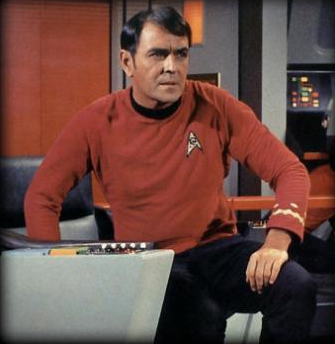 This week, the week of my birthday, I’ve been indulging myself by sharing all my thoughts about how I’d approach my dream job, being story editor on a reboot of the original Star Trek series. Yesterday I wrote about how I’d update the principal characters. Today I’ll talk about the rest of the characters and wrap things up.
This week, the week of my birthday, I’ve been indulging myself by sharing all my thoughts about how I’d approach my dream job, being story editor on a reboot of the original Star Trek series. Yesterday I wrote about how I’d update the principal characters. Today I’ll talk about the rest of the characters and wrap things up.
Mr. Scott
I think the writing of Mr. Scott is pretty straight forward in some ways. There’s not as much nuance necessary as there is with the principal characters. I love that line from the series bible about Scotty thinking of the ship as his and Kirk as merely the driver. He’s a gifted engineer and is constantly tasked with pulling off the impossible. I like the suggestion I’ve seen in various fan literature that he was there when the ship was being refitted, and that he might have served on the ship under a previous captain as well.
He’s a good friend and superior, loyal and compassionate to the men and women who serve under him. He seems to like Kirk and Spock but isn’t as informal with them as, say, McCoy – consider that in the entire series, all 79 episodes, only once did he ever call Kirk by his first name. These and other behaviors suggest that he’s a career military man.
In rebooting Scotty I think we’d leave him exactly the same, except we might want to tone down the number of times he says that the engines can’t take much more of it, and the like. In the original story bible it suggests that McCoy and he are actually pretty tight and unwind together off duty, but we never saw that. It might be interesting to see now and then.
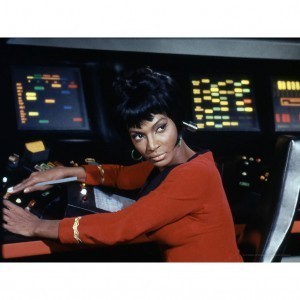 Lieutenant Uhura
Lieutenant UhuraIn the original series bible Uhura is third in the chain of command, right after Kirk and Spock, and above Sulu and even Scotty. Given that Scotty outranks her, I’d make her the senior bridge officer, which means that she could command when Kirk and Spock were away, but that Scott might sometimes be left in overall command when the captain and first officer were away for long periods. Cool as it was to see Scotty in charge in some really fine moments of the series (when Kirk was stranded on planet in “A Taste of Armageddon,” say), think how great it would have been if it was Lt. Uhura in the command chair!
When Spock’s making repairs you may note that it’s sometimes Uhura who he has assisting him. It’s implied that she’s capable and sturdy, and she even playfully banters with Spock, the only one of the junior officers who would dare to do so. Later she’s reduced to saying lines like “Captain, I’m frightened” and declaring that hailing frequencies are open. In a reboot, that former implied competence should be heightened and the other behavior dropped altogether.
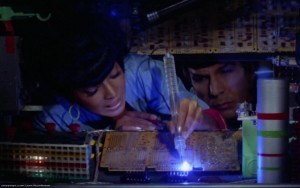 A lot of people objected to the relationship between Spock and Uhura shown in the reboot movies, but there’s actually some basis for it. Of course it was far more subtle in the original series, but then in the movies Spock suffered the complete destruction of his planet, so you can kind of understand his emotional need. In any case, in the original series there are several times when there’s some subdued flirting going on between the two. All that said, I’m not a big fan of a boyfriend/girlfriend relationship between them because it’s fraternization between the ranks, and both Uhura and Spock are, as I mentioned earlier on, professionals. In a TV reboot I’d recommend re-igniting the respect the two share for each other. Make Uhura the closest thing Spock has to a friend apart from Kirk and McCoy.
A lot of people objected to the relationship between Spock and Uhura shown in the reboot movies, but there’s actually some basis for it. Of course it was far more subtle in the original series, but then in the movies Spock suffered the complete destruction of his planet, so you can kind of understand his emotional need. In any case, in the original series there are several times when there’s some subdued flirting going on between the two. All that said, I’m not a big fan of a boyfriend/girlfriend relationship between them because it’s fraternization between the ranks, and both Uhura and Spock are, as I mentioned earlier on, professionals. In a TV reboot I’d recommend re-igniting the respect the two share for each other. Make Uhura the closest thing Spock has to a friend apart from Kirk and McCoy.
Uhura’s the head of an entire department, but she’s probably being groomed for command and being cycled through different posts to become acquainted with how all the departments work. It would be nice to see her competency in some other areas apart from communications, so long as she doesn’t become a ninja powered hand-to-hand killing machine, the cheap out anytime you want to show that a woman is competent.
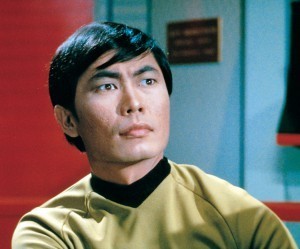 Lieutenant Sulu
Lieutenant SuluAlthough still somewhat exciteable – he’s a young officer and described in the series bible as changing hobbies about ever other week – Sulu is extremely reliable and capable, a promising young officer destined for a command of his own, well liked by his fellow junior officers and his superiors. As the series progressed we saw less and less of Sulu’s hobbies and Sulu during his downtime, but his essential portrayal as loyal and dependable always remained the same. In any reboot he should be the same guy and there would hopefully be more of an opportunity to get to know him better.
Incidentally, I was thrilled in the original series that Sulu was using a rapier, not a samurai sword. That was Takei’s idea, and I still love it. It broke the stereotype of Asian guy = must use oriental weapon. Why shouldn’t Sulu like D’artagnan over a samurai?
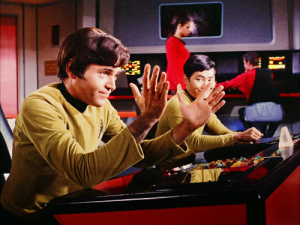 Ensign Chekov
Ensign ChekovThe story goes that Chekov was added in the second season because the Soviet Union’s Pravda newspaper complained there was no Russian character in the starship crew, although Chekov seems also to have been added to appeal to the youth market, hence the Monkee/Beatles haircut.
Chekov is more of a stereotype than the other characters, and his excessive pride in his Russian heritage is a running gag. I can see why the reboot writers made him extremely talented, which is a viable direction because we never got to know him that well. It seems as though he and Sulu are friends, and it likewise seems that he’s being groomed for various duties – witness him sometimes using Spock’s bridge scanner. Chekov would have to be expanded in a reboot. An impetuous and promising officer, but one who’s even younger and greener than Sulu. One who can more easily comment on how strange or exciting things are, and who can rise to responsibility.
Walter Koenig was told at the start of the third season that he was going to be getting more and more screen time and going forward would be treated like a young Kirk in training… but then the third season got moved to its lousy time slot and the producer got replaced and all those plans (along with episodes focused on secondary officers) never came to fruition. This abandoned plan might be a valid approach.
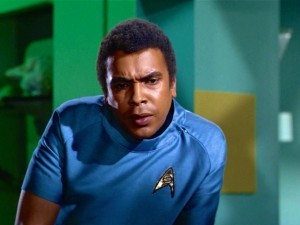 Other Characters
Other CharactersNurse Chapel was rarely more than a walking gag about a crush on Spock. She’d need to be given a specialty and a lot more personality.
Yeoman Rand was ably played by Grace Lee Whitney, so I’m not knocking her. But the character really seemed to have been created to be a sex object, someone to whom the captain was attracted whom he could never touch. If she were to be retained, her character would have to about a lot more.
There were likewise some other repeat characters, the most memorable of whom were surely Transporter Chief Kyle, (John Winston did a lot with a very limited role) and Mr. Leslie. Before any other new characters were created it would be absolutely wonderful to see folks like these (and Kevin Riley and Mr. Desalle and Lt. Galloway and Dr. M’Benga, the Vulcan specialist) be occasional recurring characters.
Series Approach
It would be great to start a rebooted series with the launch of the Enterprise at the start of the five year mission under Kirk — but a Kirk who has earned that promotion through distinguishing himself multiple times serving aboard other vessels. One thing I liked about the movie reboot was that Kirk and Spock didn’t hit it off right away, and any reboot would likely cover their growing respect and then the development of their friendship. McCoy would probably have transferred over with Kirk, along with some of the other junior officers (Sulu, perhaps) but Scott, as I mentioned above, should be a long term member of the Enterprise crew. His devotion to the ship is an essential facet of his character.
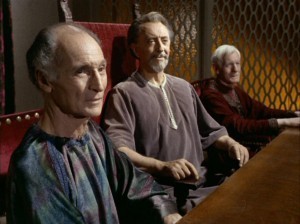 I’d plan for there eventually to be an Organian Peace Treaty from the original series– you know, the superior beings that impose the treaty upon the Klingons and the Federation — but I’d have it come a little later, say some time in season two, so we could have some more direct conflict between the two powers before things got more complicated.
I’d plan for there eventually to be an Organian Peace Treaty from the original series– you know, the superior beings that impose the treaty upon the Klingons and the Federation — but I’d have it come a little later, say some time in season two, so we could have some more direct conflict between the two powers before things got more complicated.
These days TV shows seem to have long running arcs, but it would be nice if these were kept primarily to the background and that the show remained true to its episodic nature. We’d see characters growing and changing, though – Kirk and Spock learning to trust one another, McCoy and Spock growing fond of each other despite the clashes, the crew becoming a well-oiled machine, Uhura, Sulu, and Chekov becoming better and better officers.
As to whether or not to redo old episodes, I’m of two minds. It might be really neat to re-film the best of the originals (or maybe to fix some of the iffy ones so they could fulfill their potential). On the other hand, if it was done great the first time, why re-record it?
As for where to get new stories, well, there are decades of Star Trek stories from various sources. While many of them are drek, there are some treasures out there, and a generation of writers who grew up, like me, wanting to tell new stories about our favorite crew.
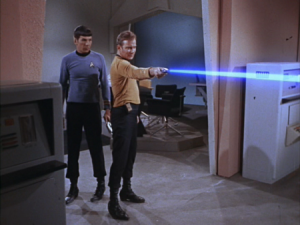 Final Words
Final WordsWell, there you have it, a whole lot of daydreaming. Anyone who’s a regular visitor knows me through some of my other interests, namely favorite writers, but this week people have gotten a full-on view of the obsessive Star Trek fan lurking behind this pleasant exterior.
Maybe a lot of us are composites of our various obsessions. I suppose I could have gone on for days about Badfinger, or The Beatles, or Hannibal of Carthage, or Harold Lamb — although I think I’ve written about him extensively enough elsewhere that it’s probably not necessary. (I wonder if you could chart a life by the things a person becomes fascinated with?)
Instead I talked with you about one of my earliest interests. I watched and re-watched and re-re-re-re-watched these episodes so much that I can walk into a room when one of them is starting and name the title within a second or two. But I’m not the only person with that superpower. There are a lot of us from my generation, and earlier, who can do that.
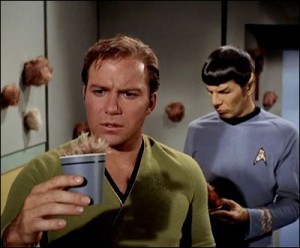 It has to be asked how feasible a Star Trek reboot could actually be. The original show was a product of its time, one that was less jaded and ironic. Again I’ll turn to Torie Atkinson’s essay over on The Viewscreen, which you should really read in full. (You should visit in any case because the reviews by Torie and Eugene Myers are always interesting and frequently insightful, as are many of the comments.) She writes that in the original Star Trek: “The characters had the courage to believe in the goodness of themselves and others, and to believe that with just a little ingenuity, they could overcome anything. There is so much passion in Trek, but it’s a bridled and mature passion. Kirk nearly bursts with the earnestness of his convictions, but his sincerity isn’t foolish or idle and his compassion doesn’t make him weak. They’re his strengths, and they make him a great leader (“The Enemy Within”). Why do we scorn these things today? We associate idealism, optimism, and sincerity with immaturity and youth, as if we must lose these things as adults—as if they’re no longer important or relevant.”
It has to be asked how feasible a Star Trek reboot could actually be. The original show was a product of its time, one that was less jaded and ironic. Again I’ll turn to Torie Atkinson’s essay over on The Viewscreen, which you should really read in full. (You should visit in any case because the reviews by Torie and Eugene Myers are always interesting and frequently insightful, as are many of the comments.) She writes that in the original Star Trek: “The characters had the courage to believe in the goodness of themselves and others, and to believe that with just a little ingenuity, they could overcome anything. There is so much passion in Trek, but it’s a bridled and mature passion. Kirk nearly bursts with the earnestness of his convictions, but his sincerity isn’t foolish or idle and his compassion doesn’t make him weak. They’re his strengths, and they make him a great leader (“The Enemy Within”). Why do we scorn these things today? We associate idealism, optimism, and sincerity with immaturity and youth, as if we must lose these things as adults—as if they’re no longer important or relevant.”
Do we think we’re too grown up for Star Trek today? It may be — yet the odd thing is that the reboot movies play down to us rather than up. They no longer seem aimed at mature people, and they don’t confront difficult ideas in a mature way. Part of that is because the requirements of a modern blockbuster movie mean explosions and action, but part of that is because there was a fundamental disconnect on the part of the men who made it about what made a story, and a character, Star Trek, as opposed to a generic science fiction show.
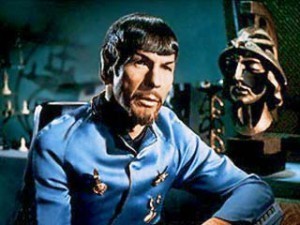 Forget about the plot flaws in the new movies (some are hard to forget, I know) because there were plenty of plot flaws in the original shows. Forget about how Kirk in the new movies was destined for the ship rather than earning it. I could forgive all of that (I could gripe, but forgive) if Kirk grew into the person he has to be to represent the best of us. But he’s just not the same guy, no matter how valiantly Christopher Pine tries, because the script won’t let him go there. He’s a milleniall hero for cinema, one interested in vengeance, not to mention one lacking Kirk’s innate compassion. He’s the new gritty dark Kirk, one step away from the version of Kirk in the popular imagination, the one mocked by comedians who shoots first and asks questions later and is always looking to bag the hot alien babe. He’s “better” because he’s allegedly more realistic.
Forget about the plot flaws in the new movies (some are hard to forget, I know) because there were plenty of plot flaws in the original shows. Forget about how Kirk in the new movies was destined for the ship rather than earning it. I could forgive all of that (I could gripe, but forgive) if Kirk grew into the person he has to be to represent the best of us. But he’s just not the same guy, no matter how valiantly Christopher Pine tries, because the script won’t let him go there. He’s a milleniall hero for cinema, one interested in vengeance, not to mention one lacking Kirk’s innate compassion. He’s the new gritty dark Kirk, one step away from the version of Kirk in the popular imagination, the one mocked by comedians who shoots first and asks questions later and is always looking to bag the hot alien babe. He’s “better” because he’s allegedly more realistic.
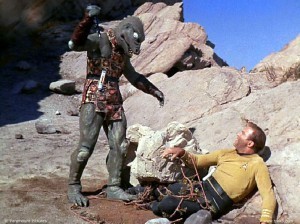 Will he and the rest of these characters grow into a closer semblance of the people I know and love? It may be. I can hope, because it seems that a lot of money was made and that these new hands will therefore be in charge of Star Trek for a while to come.
Will he and the rest of these characters grow into a closer semblance of the people I know and love? It may be. I can hope, because it seems that a lot of money was made and that these new hands will therefore be in charge of Star Trek for a while to come.
If this modern movie version of Star Trek can still be taken seriously, what about the other? And I don’t mean the one where the men’s uniforms look a little like pajamas, the one with the styrofoam rocks and the guys in suits playing the aliens. Okay, I do mean that show, but I specifically mean how the characters and the stories enabled us to look past the way it looked.
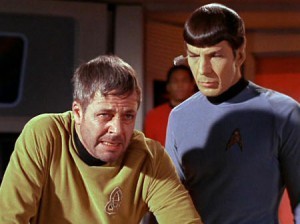 Could we have that show back? Updated not with grittiness and characters gleefully willing to kill, but updated to lose the obvious corn? You can’t lose it all, of course — how do you really make it realistic that there’s a guy from another planet who looks just like us apart from the ears? — but you can jettison the stuff that isn’t required by the feel and the characters we knew, and that’s what I’ve been talking about all this week.
Could we have that show back? Updated not with grittiness and characters gleefully willing to kill, but updated to lose the obvious corn? You can’t lose it all, of course — how do you really make it realistic that there’s a guy from another planet who looks just like us apart from the ears? — but you can jettison the stuff that isn’t required by the feel and the characters we knew, and that’s what I’ve been talking about all this week.
Finally, it must be asked whether there are still original Star Trek stories that are worth telling. The original series itself was running out of themes. Even if you ignore the ham-handed third season we were already seeing a lot of the same ideas cropping up again and again — parallel Earths, God-like aliens toying with the crew, computers that were destroying society, etc. Some variety in the formula could easily be introduced if it’s no longer necessary for Kirk to frequently have a lady to romance, and for him to always lead the landing party, sure, but are there really five years worth of sterling episodes possible even if you take the not necessarily wise step of recycling the best of them?
I’d be willing to bet that if you get the right people involved, those who really understood the feel and the characters, something amazing might happen.
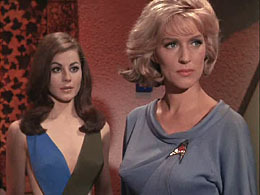 But then something amazing already did happen, and, warts and all, it is the original Star Trek. It was produced on a limited budget for a network that never really understood it, one that wanted some of the crew to smoke so tobacco companies would sponsor the show. Gene Roddenberry had to fight that idea, not to mention to get all those different ethnicities on the bridge, working together — wouldn’t a black woman alienate viewers in the south? And what was up with the satanic looking guy, the Vulcan? Did he really have to be there? (NBC airbrushed Nimoy’s pointed ears out of some of the early publicity shots.) Either he had to go, or the woman first officer from the first pilot had to go. To the network a Vulcan and a female first officer were equally unbelievable.
But then something amazing already did happen, and, warts and all, it is the original Star Trek. It was produced on a limited budget for a network that never really understood it, one that wanted some of the crew to smoke so tobacco companies would sponsor the show. Gene Roddenberry had to fight that idea, not to mention to get all those different ethnicities on the bridge, working together — wouldn’t a black woman alienate viewers in the south? And what was up with the satanic looking guy, the Vulcan? Did he really have to be there? (NBC airbrushed Nimoy’s pointed ears out of some of the early publicity shots.) Either he had to go, or the woman first officer from the first pilot had to go. To the network a Vulcan and a female first officer were equally unbelievable.
The show was made on such tight constraints it’s no wonder some of them don’t work — “Shore Leave” was pretty much revised on the set by Roddenberry himself and censors so completely gutted “The Alternative Factor” because of an interracial love story that it makes almost no coherent sense.
Taken in that context, and dogged as it was by all sorts of other turmoil you may or may not have heard about, it’s a wonder it gave us so many great things, or any good things, at all. Perhaps all we can really do is celebrate Star Trek for the tremendous achievement that it is.
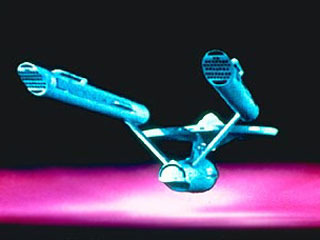 Because of the passing years it’s likely that future generations won’t be able to look past the dated depiction of the future and some of the ’60s cultural assumptions to see the intelligence and humanity there that made Star Trek a touchstone. I shall hope that something as fine is made for them. Perhaps some of you reading this might even help to create it.
Because of the passing years it’s likely that future generations won’t be able to look past the dated depiction of the future and some of the ’60s cultural assumptions to see the intelligence and humanity there that made Star Trek a touchstone. I shall hope that something as fine is made for them. Perhaps some of you reading this might even help to create it.
July 17, 2013
Trek Week, Part 4
 As threatened earlier this week, I’m going to keep imagining what I’d do given the chance to fulfill an old dream: reboot the original Star Trek show as a TV series.
As threatened earlier this week, I’m going to keep imagining what I’d do given the chance to fulfill an old dream: reboot the original Star Trek show as a TV series.
Today I’ll be talking about the main characters, but before I get into depth about any of them I want to address two things.
First, it’s true that Kirk and Spock are best friends. A lot of writers seem to think that’s where it ends. They miss something crucial, and that’s McCoy — they don’t seem to know what to do with him aside from having him snark at Spock.
Here’s the thing. All three form a greater hero.
Kirk, as is probably obvious, is the main character. He’s a man of action, but he’s also clever – an Odysseus figure. Spock is symbolic of Kirk’s rational side and McCoy represents Kirk’s intuitive/emotional side, and when the two sides are arguing we, the viewer, understand the internal dilemma that Kirk is facing. Of course, Spock and McCoy are more than this when they’re well scripted, but, swear-to-God, the interplay of these two characters is the way the viewer often sees Kirk’s worries dramatized.
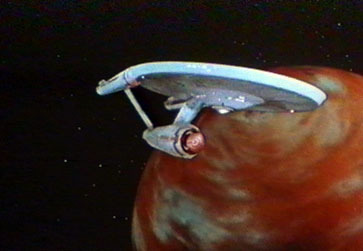 The second thing is that this is a military vessel. These people are professionals, and they should act and sound like it. They’re also in what is one of the best ships in the fleet – the Constitution class starships. That means the whole crew, from crewman on up, are well-trained and well disciplined. They’re respectful and intelligent and if they’re not seasoned, then they must be extremely talented in their particular field, or be possessed of great potential.
The second thing is that this is a military vessel. These people are professionals, and they should act and sound like it. They’re also in what is one of the best ships in the fleet – the Constitution class starships. That means the whole crew, from crewman on up, are well-trained and well disciplined. They’re respectful and intelligent and if they’re not seasoned, then they must be extremely talented in their particular field, or be possessed of great potential.
There are four main characters on the show — possibly five if you count Scotty, though you could argue he’s the most important of the secondary characters. To keep today’s post a little shorter I’m leaving a discussion about him with the secondary characters for tomorrow.
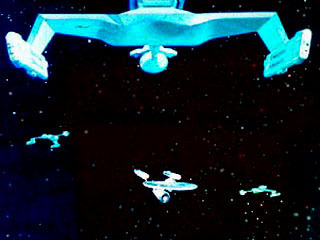 The Enterprise
The EnterpriseThe Enterprise is a special ship. It isn’t the flag ship (that would be the starship Constitution, since the Enterprise is apparently one of 13 Constitution class starships). Sure, if we’re changing a lot of this stuff in a reboot we should be able to take or leave the whole flagship conundrum, but I think it’s ridiculous that the youngest captain to ever command a starship gets the flagship of the entire fleet. In the original series, all the other captains of Constitution class ships were considerably older (so they’d outrank Kirk by seniority) and at least two were commodores. (In naval parlance a commodore usually commands a small squadron, but we can suppose that this is a nod to these ship commanders having great experience, seniority, etc. and a further sign that only the best get to command these ships.)
But I digress. As I was starting to say, the Enterprise is an important character. All the crew love that ship, perhaps none as much so as Scotty and Kirk. If the crew gives their all and takes care of the Enterprise, she’ll come through for them. Deforest Kelley, in a brief appearance in the first Next Generation episode, is given the best line in the whole episode, referring to the Enterprise: “Treat her like a lady and she’ll always bring you home.”
The Enterprise can never, ever, be treated like just another hunk of metal or a transportation device. Not only is she the crew’s home, she’s a special ship, a lucky ship, and so long as you go the extra mile for her, she’ll come through. At the end of so many episodes, when the characters sail away from some of those bleak endings (“there but for the grace of God go I”) it often seems she’s the one island of sanity in a mad universe. When the Enterprise is in danger, the audience must care. “Not with my ship,” Kirk says time and again in the original series, usually when some madman wants to do something stupid with the vessel. And we’re right there with him. We’ve got to love the Enterprise, and so should the men and women who crew her.
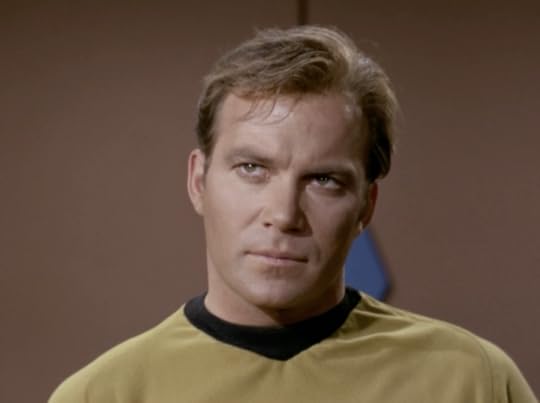 Captain Kirk
Captain KirkAs I said a few days ago, any reboot has to divest Kirk of the whole “I’m always chasing a skirt” thing and model how he’s depicted in the best episodes. First, he’s intelligent and driven, something of a loner. (Command is a lonely business.) He’s very well read, especially in history – he knows that those who don’t know their history are doomed to repeat it. He’s an incredibly gifted starship tactician. Time and again he is extremely persuasive, a born ambassador. It’s his wits, not the phasers, that get him through.
Kirk is governed by the love for his crew and his ship. He’s the youngest captain of a Constitution class starship because he earned it. He distinguished himself throughout his career (there’s a partial reading of all of his medals and awards in the episode “Court Martial” that provides just a hint about all the astonishing things Kirk has done). Nothing is more important to Kirk than his crew and his ship, and he will even risk his career to do right by them. He does not break regulations willy-nilly – he believes in the law. But in those rare circumstances when the law interferes with doing the right thing, Kirk will do the right thing. Without hesitation. (Check out this great scene — with guest star William Windom and Leonard Nimoy — from my favorite episode, “The Doomsday Machine.”)
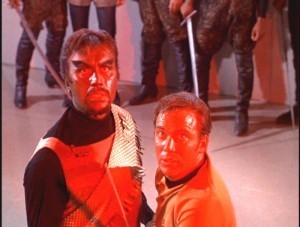 Kirk is remarkably non-judgemental and unprejudiced — unless you’re messing with his ship or crew, or the innocent. It’s telling that come Star Trek VI, when a major plot point hinged upon Kirk hating Klingons because of his son’s murder, William Shatner fought tooth and nail for the script to be changed because that kind of prejudice was completely contrary to the captain’s character. Kirk dislikes individuals, not races or nations. Countless times throughout the series where a modern, gritty character would finish off an enemy, Kirk sets vengeance aside for the greater good. He fervently believes that people are capable of change, and that they can rise above their darker instincts. Should there be no other recourse but violence, Kirk is never gleeful. He grimly does what must be done, usually with regret and always with maturity. He is always ready to extend his hand in peace… although he is no fool, either.
Kirk is remarkably non-judgemental and unprejudiced — unless you’re messing with his ship or crew, or the innocent. It’s telling that come Star Trek VI, when a major plot point hinged upon Kirk hating Klingons because of his son’s murder, William Shatner fought tooth and nail for the script to be changed because that kind of prejudice was completely contrary to the captain’s character. Kirk dislikes individuals, not races or nations. Countless times throughout the series where a modern, gritty character would finish off an enemy, Kirk sets vengeance aside for the greater good. He fervently believes that people are capable of change, and that they can rise above their darker instincts. Should there be no other recourse but violence, Kirk is never gleeful. He grimly does what must be done, usually with regret and always with maturity. He is always ready to extend his hand in peace… although he is no fool, either.
Kirk takes life and death very seriously. Every life, even an enemy life, is treated as important. Except in the weakest of all episodes (and I mean the very weakest) Kirk’s sense of duty to his men is still present. Even in a stinker of an episode like “The Apple” Kirk is visibly distraught when he loses one of his red shirts. Even though Gary Mitchell tells him command and compassion is a fool’s mixture, Kirk cares.
 Our updated depiction of Kirk retains his eyes for the ladies, but he doesn’t pursue them as often. As before, he never just uses them for his own pleasure – he’s an old school gentleman who sincerely enjoys their company. And he is professional with his crew and officers and never engages in a romance with them. He doesn’t pursue a new lovely face of the week.
Our updated depiction of Kirk retains his eyes for the ladies, but he doesn’t pursue them as often. As before, he never just uses them for his own pleasure – he’s an old school gentleman who sincerely enjoys their company. And he is professional with his crew and officers and never engages in a romance with them. He doesn’t pursue a new lovely face of the week.
It’s been pointed out by many that Kirk led too many of the landing parties, which is certainly true, and one way to give the other characters more screen time is to give Sulu, Uhura, Checkov, etc. the chance to command more away teams. But Kirk and Spock should not be excised from all of the landing parties. Just as Captain Cook was the de facto ambassador on missions, so should Kirk be, along with all the danger that implies (look what happened to Cook).
Kirk does have a playful side. He maintains a professional air with his crew, but he can banter, just a little, with the junior officers. With McCoy and Spock, of course, he can joke, though usually only when things are low stress, or, occasionally, to relieve tension.
Oh, and he may be the youngest captain in Star Fleet, but he’s still older, by 8 years or so, than Sulu, Uhura, etc.
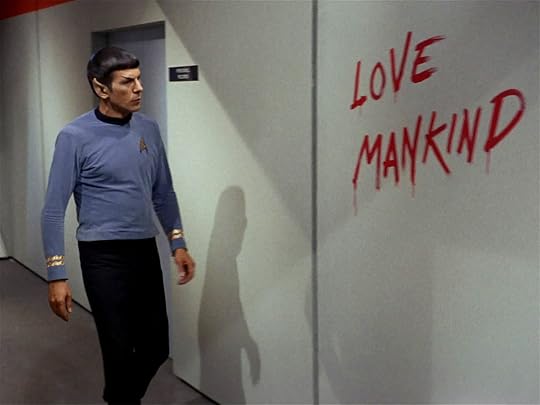 Mr. Spock
Mr. SpockWhat to say about Spock? The original series got him so very right, except in the very worst episodes, due in great part to Nimoy’s insistence on how the character was portrayed. Nimoy even demanded additional scenes and moments that would assist in Spock’s depiction (like the wonderful bit where Spock loses his cool in “The Naked Time” or the Vulcan neck pinch, which Nimoy suggested rather than doing as the script called for and slugging someone). Keep him as Nimoy played him. Study how Nimoy played him, and write him like that.
If handled improperly Spock can come off as a know-it-all, or condescending, or cold. He isn’t, even if even he sometimes thinks he is. It’s a very fine line to walk.
The original story editors got that whenever there’s any kind of special power – like the transporter – it had to have limitations lest it be used for every emergency. Same goes for the Vulcan mind meld. Always remember that the whole Vulcan mind meld thing is extremely private and means that Spock’s innermost thoughts are then shared with whomever he’s melding with. And no one else can do the nerve pinch.
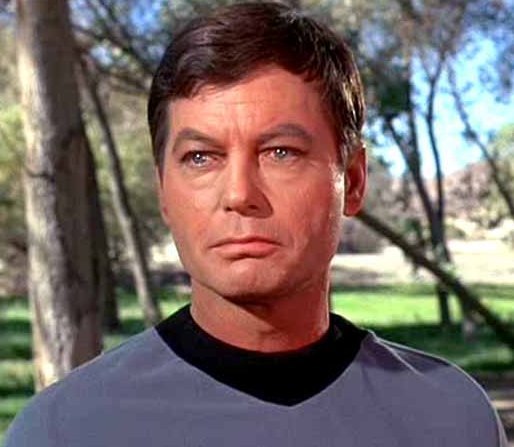 Dr. McCoy
Dr. McCoySometimes it seems like McCoy is reduced only to a couple of catchphrases. Sure, use those catchphrases from time to time, but remember they really didn’t come up that often in the series (sort of like the above-mentioned superpower rule). Out of 79 episodes McCoy really didn’t say “he’s dead Jim” or “I’m a doctor not a placeholder” that many times.
McCoy is gruff with a heart of gold, Kirk’s sounding board and bartender/therapist. He’s older than Kirk by 8 or 10 years. He can quickly lose his temper but just as quickly cool down, and is extremely sensitive. It should not be forgotten that he’s fearless – not reckless, but fearless. He stood up even when threatened by Khan, who ended up respecting him. He’s more willing than any other character to publically speak up and be a little insubordinate in front of the brass.
Probably the toughest thing to get right with McCoy is his relationship with Spock. Even some of the episodes handle it roughly. In “The Tholian Web” (one of the rare decent episodes from the third season) McCoy is overly sharp and sarcastic with his Vulcan friend. They have differences of opinion but are deeply respectful of each other at the same time, and come to love each other like brothers.
Right, well, I could have gone on a lot longer, but, God knows, this is probably going on too long already. Tomorrow I’ll look at the remaining characters and do a final wrap-up.
July 16, 2013
Trek Week, Part 3
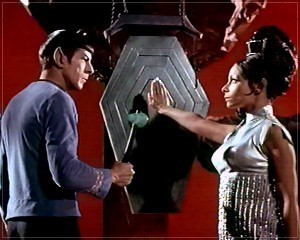 I was so inspired by Star Trek Continues that I decided to dedicate the week of my birthday to talking about my first great fictional love, the original Star Trek. Today I’ll start rambling about all the things I’ve always wanted to do if I got to be the executive story editor of a rebooted Star Trek TV show. Yeah, I know, it’s pretty self indulgent, and I’m ashamed to say I’ve spent way too much time over the years thinking about this. But my birthday’s coming up, so you’ll forgive me, right?
I was so inspired by Star Trek Continues that I decided to dedicate the week of my birthday to talking about my first great fictional love, the original Star Trek. Today I’ll start rambling about all the things I’ve always wanted to do if I got to be the executive story editor of a rebooted Star Trek TV show. Yeah, I know, it’s pretty self indulgent, and I’m ashamed to say I’ve spent way too much time over the years thinking about this. But my birthday’s coming up, so you’ll forgive me, right?
I think I should make a certain mindset absolutely clear as I go forward. Canon cannot be a stumbling block. Star Trek canon itself is inconsistent. (For example, it was Vulcanian before it was Vulcan and Starbases used to be called Earth Bases.) Even details from really good episodes can be problematic — for instance, could the space battle that happens a century before the start of “Balance of Terror” really have taken place using only sublight vessels? Wouldn’t those ships have had to leave Earth a few thousand years before now to get there in time to fight the Romulans?
All these things and many more present canon problems, but nothing so much as the behavior of the characters themselves. Which is the real Uhura — the one who bravely sasses Sulu in “The Naked Time” or the one who frequently tells Kirk “I’m frightened?” How do we reconcile the deep, complex, nuanced characters in “Amok Time” with the idiots we see in episodes like “And the Children Shall Lead” and “Plato’s Stepchildren?” In those clunker shows the characters don’t even talk much like themselves, no matter that the familiar actors are playing them.
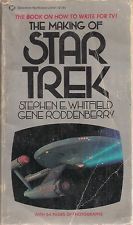 Anyone rebooting the original Star Trek as a TV series has to be able to free themselves of the idea that everything the series showed us has to happen. What must remain fundamentally the same, however, are the characters. To be Star Trek, the crew has to consist of the same people we saw in the best moments of the series. Of course all the Star Trek universe’s underpinnings should be the same — Federation, Klingons, transporters, the Enterprise out on the edge of explored space, etc. Nothing matters quite as much, though, as the characters and the feel. If you don’t get the characters and the feel right, you don’t have the real Star Trek, no matter how big your budget. (I’ll be talking about the characters later, and I’ll add that anyone truly serious about rebooting Star Trek should read Stephen Whitfield’s excellent The Making of Star Trek for its lengthy discussion of them.)
Anyone rebooting the original Star Trek as a TV series has to be able to free themselves of the idea that everything the series showed us has to happen. What must remain fundamentally the same, however, are the characters. To be Star Trek, the crew has to consist of the same people we saw in the best moments of the series. Of course all the Star Trek universe’s underpinnings should be the same — Federation, Klingons, transporters, the Enterprise out on the edge of explored space, etc. Nothing matters quite as much, though, as the characters and the feel. If you don’t get the characters and the feel right, you don’t have the real Star Trek, no matter how big your budget. (I’ll be talking about the characters later, and I’ll add that anyone truly serious about rebooting Star Trek should read Stephen Whitfield’s excellent The Making of Star Trek for its lengthy discussion of them.)
But as to that feel – no one has ever described it so well as Torie Atkinson in an essay she wrote after viewing the first season of Star Trek for the very first time. I’ve read many a fine essay about the power of Star Trek over the years, but no one has ever conveyed it as well as Ms. Atkinson. I’ll excerpt part of it here, and then you should drop by the site and read the entire thing (click on the text below to get there). Anyone involved in a Star Trek TV reboot should read and re-read this essay and thoroughly understand it. Hell, anyone involved in a Trek reboot should make sure to ask Torie Atkinson on board to assist the effort.
Alright, you back with me? Great. Now let’s get to the nitty gritty.
What people who are removed from Star Trek (say, movie producers) never seem to get is that most fans don’t like Trek because of the cheesy styrofoam boulders or the now dated special effects. We like it in spite of those things. We don’t want them anymore. We may smile fondly at the fact Kirk so often romances the pretty guest stars, or smirk that hey, look, another red shirt’s about to die, or, hey, Kirk’s going to out-logic another computer or stop another villain with a fist fight, but that’s just because we love our show, warts and all. Those aspects are not why we tuned in. Those artifacts from the ‘60s don’t need to remain.
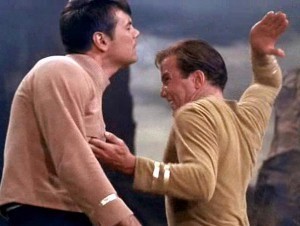 The fistfight at the end? That’s because the original network executives didn’t like the first show pilot because it was too cerebral. Gene Roddenberry made sure the second show pilot ended with a western style brawl to please them, and he kept it up. The death of security guards? A shortcut to let us know that matters in the story had gotten serious, one that got to be lazy shorthand. The Kirk romances? Another ‘60s artifact because it was thought the leading man always needed to be showing his prowess with the ladies. Sure, Kirk has an eye for the ladies, but he doesn’t need to have a romance every episode. In the first season those moments were more rare, and Kirk sometimes used his manly powers not because he was interested, but to save the ship. By the second season the Kirk lovin’ had gotten sloppy and far too frequent. We’d have to cut way back on that.
The fistfight at the end? That’s because the original network executives didn’t like the first show pilot because it was too cerebral. Gene Roddenberry made sure the second show pilot ended with a western style brawl to please them, and he kept it up. The death of security guards? A shortcut to let us know that matters in the story had gotten serious, one that got to be lazy shorthand. The Kirk romances? Another ‘60s artifact because it was thought the leading man always needed to be showing his prowess with the ladies. Sure, Kirk has an eye for the ladies, but he doesn’t need to have a romance every episode. In the first season those moments were more rare, and Kirk sometimes used his manly powers not because he was interested, but to save the ship. By the second season the Kirk lovin’ had gotten sloppy and far too frequent. We’d have to cut way back on that.
Naturally the sexism would have to go. For the time, the women on the show seemed pretty liberated – they had respected positions among the men and clearly had responsibilities. Now it’s obvious that the men on the ship still had all the important posts. This would have to change.
There’s no way you could possibly alter the sex of any of the main characters, as was done on the Galactica reboot. All fans, me among them, would be up in arms.
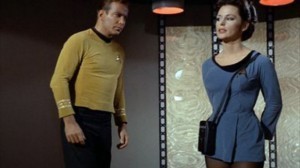 Instead you’d have to shore up the parts of both Lt. Uhura and Nurse Chapel, and possibly bring back Yeoman Rand, although her role was really just for eye candy, as even the original series bible seems to suggest. Uhura, according to the series bible, was pretty high up on the chain of command. If Kirk and Spock are away on a mission or off duty then by God, she should have the conn.
Instead you’d have to shore up the parts of both Lt. Uhura and Nurse Chapel, and possibly bring back Yeoman Rand, although her role was really just for eye candy, as even the original series bible seems to suggest. Uhura, according to the series bible, was pretty high up on the chain of command. If Kirk and Spock are away on a mission or off duty then by God, she should have the conn.
As with both pilot episodes, female uniforms could be either some kind of dress or slacks so that it wouldn’t look like the women were required to don sexywear to serve on the ship. But I’d suggest one other change. Add another important female character. Who, you ask?
Apart from two first season episodes, where Lt. Commander Kelowitz makes an appearance, we never see nor hear from a chief of security. And it seems like that security perspective would have been necessary on board a starship. Add a female head of ship’s security, preferably one of Indian or Arabian descent. She wouldn’t be firing the ship’s weapons (wouldn’t we all miss Sulu firing those?) but she’d be involved in all away teams and the ship’s security issues that always crop up, and be there for all the briefing room meetings. Perhaps she could be the one raising and lowering the deflector screens and have a bridge position, as the security chief on the fan-produced Exeter starship episode was doing.
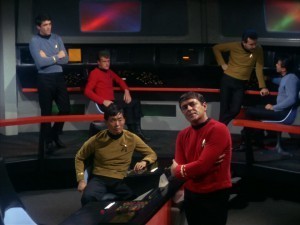 Let’s take a look at sexuality. The ‘60s Star Trek was all about inclusiveness and our essential humanity, be a character Asian, black, Vulcan, or even a Ruskie. Today it’s time there was a major gay character. The cheap out would be to create an all-new homosexual character, say, Lt. Gaybob, Chief of Geology. And that would be really, really lame. Homosexuality should be just an aspect of a character rather than a defining characteristic. Like, you know, a real person. I can hear you saying, oh, okay, so then how about we make this new character you propose, this security chief, a lesbian?
Let’s take a look at sexuality. The ‘60s Star Trek was all about inclusiveness and our essential humanity, be a character Asian, black, Vulcan, or even a Ruskie. Today it’s time there was a major gay character. The cheap out would be to create an all-new homosexual character, say, Lt. Gaybob, Chief of Geology. And that would be really, really lame. Homosexuality should be just an aspect of a character rather than a defining characteristic. Like, you know, a real person. I can hear you saying, oh, okay, so then how about we make this new character you propose, this security chief, a lesbian?
But I’d say that’s still a cop-out. I’d argue for changing the perceived sexuality of one of the tried and true characters. And no, not Sulu. Just because he was played by a homosexual man doesn’t mean the character is gay. George Takei himself has said Mr. Sulu is not gay. As a matter of fact, making Sulu gay because Takei has come out is just as insulting as inventing Lt. Gaybob the geologist.
No, I’d say it would be better if either Chekov, Scotty, or McCoy were homosexual. Sure, each of them had some episodes (mostly pretty weak ones) where their character was in a romantic relationship with a woman, but is the sexuality of any of those characters their defining characteristic? Nope. I don’t think changing their sexuality would matter in the least to any story or their characters so long as you keep the series feel — meaning no romantic tension between the character and the other primary characters on the ship. That kind of unrecquited romance would play right to the fear some straight men seem to have that gay men probably want to hit on them. Believe it or not, it’s possible to be straight and have a close friend who’s gay. Really.
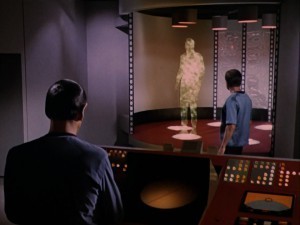 Speaking of transformative changes, the transporter was a pretty cool special effect. I honestly think the old gold sparkle still looks better than all the fancy new improved versions we’ve seen over the years. It was much cheaper to beam people around than to show the ship landing on a planet each week, or to depict a bunch of involved docking procedures. The problem was that when the stuff hit the fan, Kirk and the landing party could just get the hell out of there, problem solved, no worries… and no tension. Thus the writing staff had to do some quick tap dancing and provide limitations.
Speaking of transformative changes, the transporter was a pretty cool special effect. I honestly think the old gold sparkle still looks better than all the fancy new improved versions we’ve seen over the years. It was much cheaper to beam people around than to show the ship landing on a planet each week, or to depict a bunch of involved docking procedures. The problem was that when the stuff hit the fan, Kirk and the landing party could just get the hell out of there, problem solved, no worries… and no tension. Thus the writing staff had to do some quick tap dancing and provide limitations.
First, the transporter would take a while to lock on and you had to stand still. So, no beaming in the midst of a chase situation. Second, you couldn’t beam things in or out when the ship’s deflector screens were on, which is why you couldn’t simply lock onto your enemies as you were getting ready for a fight and beam ‘em into space (problem solved, again, too easily). Also, the Enterprise had to be in a tight orbit to actually be close enough to beam people around.
If you don’t keep all of these limitations in mind (and be ready with others as needed, for example, ion storms a la “Mirror Mirror”), then you end up with all kinds of story problems, which is why my mind was seriously boggled when, in the first reboot movie, the crew was beaming not only halfway across the solar system,but across vast interstellar distances. The transporter is difficult enough to use and still maintain plot tension. If you make it capable of beaming wherever, whenever, your writers are quickly going to run into problems down the line. Let’s keep the transporter the way it used to be, save that it should be clear that there’s more than one transporter room (there are probably several scattered through the ship, as various blueprints have suggested over the years).
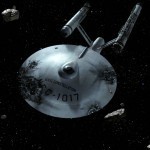 As for the look of the ship — well, it would obviously have to be updated and given chairs that don’t fall over, but I think the basic floorplan should remain — really, it’s an excellent bridge design except for the fact it seems to be at the top of the ship, for no good reason. Any changes made to ship or uniform would have to be well considered. Updated, but reminiscent.
As for the look of the ship — well, it would obviously have to be updated and given chairs that don’t fall over, but I think the basic floorplan should remain — really, it’s an excellent bridge design except for the fact it seems to be at the top of the ship, for no good reason. Any changes made to ship or uniform would have to be well considered. Updated, but reminiscent.
Tomorrow I’ll start talking about updating the characters.
Trek Week, Part 2
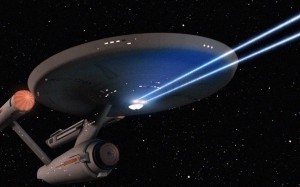 Trek week continues on Jones central for the whole week of my birthday. Regularly scheduled posts will resume next week. Be warned: if you’re not a fan of the original show, your eyes may glaze over.
Trek week continues on Jones central for the whole week of my birthday. Regularly scheduled posts will resume next week. Be warned: if you’re not a fan of the original show, your eyes may glaze over.
I’ve spilled any number of kilobytes of data about how much I’ve been influenced by writers like Leigh Brackett, Harold Lamb, Robert E. Howard, Roger Zelazny, Fritz Leiber, C.S. Forrester, Saki… the list could go on. Yet I’ve seldom discussed the influence of my first great fictional love, the original Star Trek.
I was 4 in 1972. My friend Mike Boone gave me the first phone call I’d ever received and told me that the “new show” he’d told me about was on (we were 4 and probably didn’t know about re-runs) and my dad allowed me to flip the channel. There were Kirk and Spock, beaming down in the episode I later learned was titled “Patterns of Force.” To make a long story short, my little mind was blown, and pretty soon I was a fan for life.
I couldn’t see the sexism, any more than the women on the show, who apparently found the miniskirts liberating. I didn’t even notice the cheese, and I certainly didn’t perceive much problem with the special effects, which in ’72 were still pretty cutting edge. What I saw at age 4 and for years to come was a band of people from different cultures who worked together to overcome adversity and had amazing adventures.
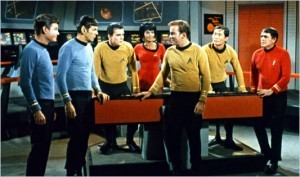 When I first started trying to write stories it should come as no surprise that I tried writing some Star Trek. By the late ’70s there were original Star Trek novels out there, many of them pretty bad, so I figured if they could do it, so could I. Sometimes I wrote about the familiar characters and sometimes I wrote what’s now called fan fiction about my own crew aboard the starship Yorktown, which I decided was the only other Constitution class ship that made it back from its five year mission mostly intact.
When I first started trying to write stories it should come as no surprise that I tried writing some Star Trek. By the late ’70s there were original Star Trek novels out there, many of them pretty bad, so I figured if they could do it, so could I. Sometimes I wrote about the familiar characters and sometimes I wrote what’s now called fan fiction about my own crew aboard the starship Yorktown, which I decided was the only other Constitution class ship that made it back from its five year mission mostly intact.
By the end of high school I finally came face to face with the fact that some of the show’s special effects were dated and that some of the episodes were a lot better than others (almost all of the shows in the third season are quite weak, but there are some stinkers in season 1 and 2 as well) and that there were a whole lot of little issues that made the whole thing unravel if you thought about it too hard. But even though I might have made surface noises about the show’s problems, I still loved it. I grew to realize that more than anything, even, perhaps, more than a novelist, I wanted somehow to be the story editor on a new Star Trek series. That may still be my dream job even today.
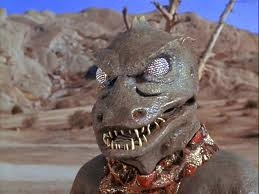 When my good friend Bruce brought the first episode of Star Trek: The Next Generation, which he’d taped off of a Canadian station before the show was available for viewing here in the US, I was thrilled, even if, when asked if it were good, he said only “well… it has potential.” Yeah. On viewing, that was kind of my feeling as well. I watched faithfully for the first year and then pretty much gave up. I’m told that by the fourth season it got pretty good, and I’ve caught individual episodes from later on that were enjoyable, but I never got heavily invested, and I was busy enough later in life that I never got sucked into any of the other series. Maybe I was always irritated that it took at least three years for the Next Generation to get good, and my favorite show got lobotomized after only two.
When my good friend Bruce brought the first episode of Star Trek: The Next Generation, which he’d taped off of a Canadian station before the show was available for viewing here in the US, I was thrilled, even if, when asked if it were good, he said only “well… it has potential.” Yeah. On viewing, that was kind of my feeling as well. I watched faithfully for the first year and then pretty much gave up. I’m told that by the fourth season it got pretty good, and I’ve caught individual episodes from later on that were enjoyable, but I never got heavily invested, and I was busy enough later in life that I never got sucked into any of the other series. Maybe I was always irritated that it took at least three years for the Next Generation to get good, and my favorite show got lobotomized after only two.
As the years rolled on I’ve kept thinking about the original Star Trek from time to time, and how I would handle a reboot were I ever so lucky as to take the reins as series story editor. And for the rest of the week I’m planning to subject you to those thoughts.
July 15, 2013
Star Trek Continues
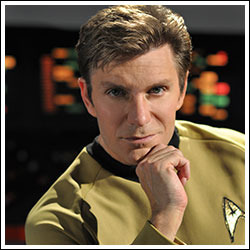 I’d like to buy Vic Mignogna a drink.
I’d like to buy Vic Mignogna a drink.
I’m not a drinking man myself, and for all I know, he might not be either. But he deserves that drink, be it scotch or root beer. Not just because Mignogna brought to life my favorite anime character (Edward Elric, from Full Metal Alchemist: Brotherhood –for which Mignogna received a best actor award) but because he got Kirk right.
If you’re not a fan of the original Star Trek series you can probably stop reading here.
Mignogna didn’t just get Captain Kirk right, he was one of the executive producers, not to mention the director, of an excellent fan produced Star Trek episode, Pilgrim of Eternity, written by Steve Fratt and Jack Trevino. (Everyone involved deserves a round of drinks.) He also was responsible for scoring some additional music for the episode.
That’s not all — Mignogna also had the courage to admit that he loved the original series so much that he used to tape record episodes… which I somewhat shamefacedly must admit I did myself. That was in the days before videotape, understand, so that was the only way to possess a copy of an episode, short of breaking into the local affiliate broadcasting the reruns and making off with the film.
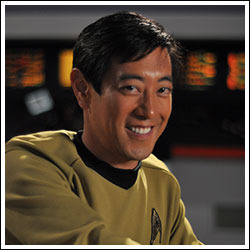
Yes, that really IS who you think it is playing the part of Sulu…
I don’t want to gas on for too long here — I’ve got a very long post about to go live over at Black Gate that will provide you with far more details, but Mignogna was instrumental in bringing to life a dream shared by many: giving us one more Trek episode that felt like the original show.
Mignogna has a vocal range that’s pitched higher than Shatner’s. But everything else is just about pitch perfect. He has the body language down. He moves like Kirk in large ways and in small. He avoids performing a caricature of William Shatner because he’s not playing Shatner, he’s playing the character Shatner played. He seems to understand what the reboot got so wrong: Kirk’s a dedicated, driven serviceman whose ship and crew come before everything else. He rose through the ranks because of his talent, and he’s been hardened by tragedy and triumph in the face of adversity.
Most Trek fans like Kirk not because of the cheese or because in ‘60s TV he was often depicted as a skirt chaser, we like him in spite of those things and wish we saw less of them. In the best episodes Kirk’s a professional. Mignoga is playing that Kirk. The one we saw when the scripts were at their best. When, mid-way through the episode, Kirk gives one of his patented speeches even when his life hangs in the balance, Mignogna is channeling the same character. It’s just an incredible performance.
Now for all of this praise there’s a caveat: don’t go clicking over expecting to see another Doomsday Machine or The Trouble with Tribbles. It would hardly be fair to expect a team of people doing all of this in the spare time to have produced something to rival the series greats. But this script could easily stand up beside many a B grade episode, like By Any Other Name, or The Return of the Archons, say. It’s impressive work, and better than a huge swathe of third season episodes. My hat is well and truly doffed to writers Steve Fratt and Jack Trevino. They get Star Trek.
As I said above, I’ll have a more extended review over at Black Gate, along with some praise for some additional cast members, some of whom are truly outstanding. If you’re an original series fan, take some time this evening and go watch this episode.
July 11, 2013
Of Blackhearts, Laptops, and Turkeys
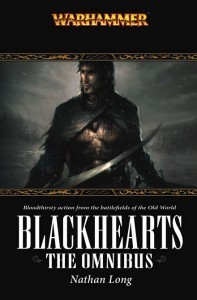 First, a link I thought a lot of my visitors might find of interest. My friend Nathan Long, vastly underappreciated master of sword-and-sorcery adventure, penned a really neat look at the underdog in sword-and-sorcery over at his own site. If you haven’t already, you should swing by and take a look. Here’s the link.
First, a link I thought a lot of my visitors might find of interest. My friend Nathan Long, vastly underappreciated master of sword-and-sorcery adventure, penned a really neat look at the underdog in sword-and-sorcery over at his own site. If you haven’t already, you should swing by and take a look. Here’s the link.
Nathan’s written some fabulous s&s stuff, but if you’re not a reader of Warhammer novels you probably haven’t heard of him. Whatever you might think of tie-in work, you must realize that with so much of it out there some is head and shoulders above the others. And some towers not just above its peers, but stands with the truly great giants of sword-and-sorcery. (Yes, I think that highly of Nathan’s stuff.) Nathan’s Long Blackhearts books (along with C.L. Werner’s Brunner stories, some of William King’s Gotrek & Felix novels, and more work by Long) should really be widely read and praised by any lovers of adventure fantasy.
Second, in brief, I am really enjoying this new MacBook Pro computer. I cannot stress this enough. What a solid laptop with great key action, responsiveness, and ease-of-use. It’s wonderful having such a fabulous tool at my disposal.
 Third. While up in central Indiana last weekend the family spent some time hiking the trails of Turkey Run State Park. It’s just a lovely place to visit, with wonderful scenic canyons. Yes, canyons with splendid rock formations. One doesn’t usually think of canyons in central Indiana, but Turkey Run has them, and they’re gorgeous. My family enjoys visiting so much we’ve tried to drive there at least once a year, and my son told me this time it’s one of his favorite places in the world.
Third. While up in central Indiana last weekend the family spent some time hiking the trails of Turkey Run State Park. It’s just a lovely place to visit, with wonderful scenic canyons. Yes, canyons with splendid rock formations. One doesn’t usually think of canyons in central Indiana, but Turkey Run has them, and they’re gorgeous. My family enjoys visiting so much we’ve tried to drive there at least once a year, and my son told me this time it’s one of his favorite places in the world.
If you’re nearby and have never visited, I highly recommend the experience. We find trails 3 and 4 the most stunning… though if it’s been raining you should bring some waterproof shoes, because creeks run through the canyons and you’re apt to get muddy while you hike.
Fourth and last, I’m back to work on my secret series project, which I’m now calling Hearthstones, although that assuredly won’t be the finished title. I am pretty excited about it.
July 10, 2013
Man At Work
 All morning I’ve been transferring files from my Asus laptop to my brand new MacBook Pro.
All morning I’ve been transferring files from my Asus laptop to my brand new MacBook Pro.
The old one isn’t dead and had served me well except for the partly broken hinge and the annoying way that lightly brushing against the touch pad sets the cursor jumping around. The main reason I updated was so that my son, now in high school, would have a computer he could primarily call his own. More and more often I was having to loan it out to him to work on school projects or, this summer, to work on the music composition program Finale.
I wasn’t actually planning on a Mac. I’d sold off several hundred dollars worth of old books and games and the like in preparation for picking up a new PC. Then I became a little overwhelmed with reviews of various PC laptops — perhaps you know the routine. One site would say great things about a particular model, another wouldn’t, and, not being a regular browser of PC computer reviews I always wondered if the review site was legit, or secretly a commercial for one of the brands.
On top of that, after I’d get my list of laptops I was most interested in together, I’d discover the local stores didn’t have those models. Meanwhile, my wife was using her MacBook Pro, as she’s been doing for some years now, and as she was doing on another Mac for years prior. And suddenly it dawned on me that maybe the extra money would be worth the sense that A. I would be getting something good B. It would last for a very long time.
So here I am.
July 9, 2013
Writer at Work
Due to some (non-emergency) family stuff here I’ve gotten a later start than planned, so today I need to dive right into the creation of some prose rather than taking a little time for a longer post.
But here’s a tasty tune in the mean time.
July 8, 2013
Jones Adventures on the 4th of July
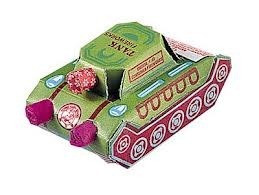 It’s been a relaxing weekend here at Jones central. On Thursday afternoon we saddled up the horses and rode around the pasture for a while. Some family friends came by and the thought was we might pull out Martian Rails, but the weather was so nice we just remained outside after the pitch-in dinner.
It’s been a relaxing weekend here at Jones central. On Thursday afternoon we saddled up the horses and rode around the pasture for a while. Some family friends came by and the thought was we might pull out Martian Rails, but the weather was so nice we just remained outside after the pitch-in dinner.
We could see some fairground fireworks going off over the hill, and the new neighbors, atop said hill, seemed to have sunk a chunk of change into fireworks themselves, because some pretty big stuff was launched into the sky. Our own fireworks display was much more subdued, although our old friend Bruce brought some pretty cool ones.
Some of the most delightful moments came when something went slightly awry. For instance, I discovered I’d purchased a box of cardboard tanks a few years back, and we set them rolling on the drive way. Anyone who has lit up those tanks knows they generally don’t roll very far, which was true for most of these. One, though, worked exactly as must have been intended by the designer, except for the sudden ninety degree turn. Not only did it zoom ten feet at a pretty good clip, when it launched its fireworks it wasn’t a bright fizzle, but a projectile that went halfway to one of the cars!
 The other highlight was launching balloon lanterns into the sky and watching them drift away. If I’d known how neat that was going to be, I would have purchased one for each of us. Next year. After, we sat around a campfire roasting marshmallows and making s’mores.
The other highlight was launching balloon lanterns into the sky and watching them drift away. If I’d known how neat that was going to be, I would have purchased one for each of us. Next year. After, we sat around a campfire roasting marshmallows and making s’mores.
More adventures followed over the rest of the weekend, one at least of which might be interesting for families with younger children. I’ll detail those tomorrow.
Writing wise I finished a rough draft of one Pathfinder story and drafted a rough of another, much shorter one.
And I keep contemplating the calendar and the upcoming 45th birthday. Sheesh. When did THAT happen?
July 3, 2013
Landstalker
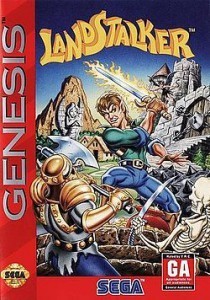 For the last week or so my son’s been playing an old Sega adventure game called Landstalker, aided by my wife. I bought it for my wife years ago when she couldn’t find anything to satisfy her Zelda fix (anyone who plays the Zelda-style adventure games knows that there are long gaps between releases of new games). I think it might have been a used game when I picked it up for her, because when I looked it up the other day on the interwebs I discovered it was more than a quarter century old!
For the last week or so my son’s been playing an old Sega adventure game called Landstalker, aided by my wife. I bought it for my wife years ago when she couldn’t find anything to satisfy her Zelda fix (anyone who plays the Zelda-style adventure games knows that there are long gaps between releases of new games). I think it might have been a used game when I picked it up for her, because when I looked it up the other day on the interwebs I discovered it was more than a quarter century old!
I’ve since made two deductions. First, it’s pretty neat that an older style game can still prove completely entertaining and immersive to someone from the new generation. Second, when did I get so old that a game I saw played as an adult is now 25 years old?
Howard Andrew Jones's Blog
- Howard Andrew Jones's profile
- 368 followers



